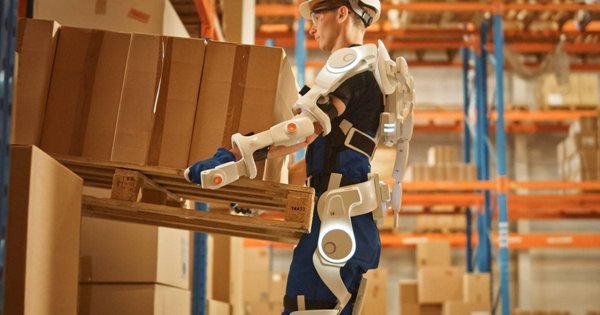Due to the extreme physicality of their job, it’s no surprise that as many as 30% of construction workers end up missing work due to back injuries. The long hours, repetitive movements, unequal lifting, and heavy tool belts make construction the number one occupation resulting in lower back pain. However, new technology is offering hope to the backs of construction crews, health care workers, soldiers, and agricultural workers everywhere in the form of exosuits.
What are they?
Exosuits, sometimes called exoskeletons, are wearable frameworks that provide back and joint support and lower the forces that can lead to injury, chronic pain, and fatigue. Exosuits have been around since the 1960s, but their bulk and rigid structure restricted movement and made working in tight spaces difficult. Despite the better physical support for users, this inability to complete their jobs quickly and efficiently led many workers to abandon their use.
Exosuit creators have been listening to feedback, and many new models appeared on the market in the last several years, with even more technological enhancements expected to appear by 2025.
Types of Exosuits
“Soft-shell” suits, also called soft exosuits, are becoming popular because they provide extended mobility while still providing support. Corporations like Toyota and Walmart have started testing new suits with sensors that alert workers when they’re engaging in risky movements. These suits also collect data that give employers insight into which jobs and tasks pose the highest risk of injury. If successful, employers could then use this data to improve workplace design and equipment.
New robotic exosuits are also expected to revolutionize the construction industry. Originally designed by the military and later used in healthcare, these suits might make you think of Tony Stark and Ironman. Consisting of a metal framework fitted with motorized muscles, these suits multiply the wearer’s strength, making objects feel significantly lighter and leading to fewer injuries on the jobsite.
Suits also come in two categories: passive, which means there are no batteries, actuators or motors to assist with physical activity; or active, with technology that takes on some of the load for the wearer. Some examples of passive suits include overhead exosuits that offer neck, shoulder, and arm support while workers perform overhead installation work, and chairless chairs, which lock in place to support workers who are crouching or standing in the same position for a long period of time.
Active suits might include arm support limbs that let workers lift heavy tools, as well as full body suits that use compressed air to take most of the lifting load off the wearer.
The Future of Exosuits
While most employers would jump at the opportunity to keep their workers safe and compliant, the cost of exosuits has often been a deterrent. However, exosuit prices have been dropping since 2015. As technology gets better and more affordable, it’s only a matter of time before every construction site adopts this powerful tech.
Whether it’s active or passive, soft-shell or robotic, we’re excited to see how exosuit technology will continue to expand, creating new and innovative ways to protect our workers and make sure your projects are done on time, every time.

